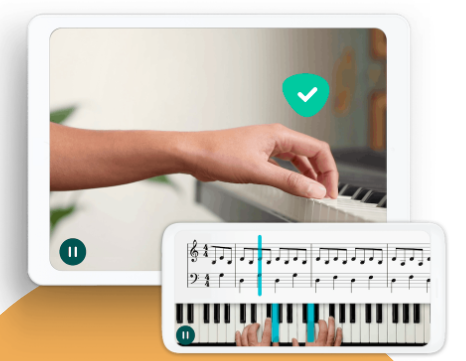While I don't love the idea of adding even more screen time to my day, I have to concede that piano learning apps are an accessible and affordable way to get started on the piano. I always advise that in-person lessons are the best way to learn for pretty much everyone, but frankly, they're not always going to be within reach for a lot of aspiring pianists. So I'm on a quest to find the best piano learning apps for all kinds of players in hopes that my readers will get started on the right track.
Skoove is one such piano learning app that takes a similar tack to many of its competitors but also brings its own set of unique features to the table. I found it to be less gamelike than a lot of the other apps out there, and so perhaps is better suited for adults and/or players who prefer a slightly more serious approach to learning.
I'm a lifelong musician with over 20 years of professional experience—pretty good guitar player!—terrible piano player. In this review, I'll go over my experience signing up for and taking a few lessons with Skoove, giving you my firsthand impressions and takeaways.
Together, we'll determine whether this app will be worth your money, or if you're better off picking another one of our favorite piano learning apps. Let's check it out.
SPECS:
- Subscription: $29.99/Month, $59.99/3 Months, $149.99/1 Year (with 7-day free trial)
- Features: One-on-one lessons, AI analysis for real-time feedback, looping with tempo control, wide range of music selection
- Content: Techniques, music theory, sight reading, improvisation
Overview
With a heavier reliance on sight-reading sheet music and less of a “bouncing-ball” vibe, Skoove allows you more freedom to practice in free time along with your sheet music, providing an overall experience that felt, to me, more similar to what real in-person lessons are like.
That said, its freewheeling structure lacks accountability and might not be ideal for players who are just starting out, as it takes a great deal of discipline to get through the early stages. And, like most piano learning apps, it's not really designed with advanced players in mind either.
But that leaves it a solid position as a good app for intermediate players, or at least players with some piano experience.
Skoove Review: The Nitty Gritty
Getting started with Skoove is easy. All you need is a mobile device and your keyboard. I didn't have any problems playing along and getting feedback using the phone's internal mic. Like most similar apps, you take a little pop quiz regarding your goals and musical interests, and then you're off.

My first lesson was “Big Ben Melody” (AKA doorbell—Ding-Dong-DANG-Dong…). I selected Classical as well as Jazz and Blues as my genre preferences—your results will likely vary! And this was actually lesson one of Beginner II, because I said I had some experience when setting up my profile. So, simple melody—but with two hands and reading a few notes on the bass clef. Thanks to my prior experience with Yousician and Simply, I was ready!
This was a bit harder… I screwed up over and over again. Mistakes aren’t too painful, though, just a gentle red dot for correction and a chance to try again. You can also restart lessons at any time if you want to improve your score. Initially, in the “Finger Gym” exercise, the timing is not so strict as you are just playing solo without a backing track, so it’s a bit more forgiving than jumping right in with the full track.
All-in-all, this is a bit more similar to in-person lessons. You can make a mistake and just keep right on going, albeit with gentle correction.

But don’t think they are letting you off that easy—because once you get the section down, you’ll repeat it, with the metronome on this time. Then, if you nail that, you’re prompted to do it again with a faster tempo.
Once you finish that, you’ll finally play the song with the “band” (backing track). It doesn’t score you on this section (at least it didn’t for me on my first lesson), you just jam along and enjoy the new skills you’ve learned. And finally, you get a full score view to practice on your own, unaccompanied—just old-school sight reading—if you wish.
Tools and Features
There’s an unintimidating selection of useful tools you can use to sharpen your skills. The looping tool allows you to sort of zoom in on difficult sections. You can decrease the tempo for the selected section to really nail it before moving on.
Now, if you’re like me and have some level of experience, you can indicate that when starting your journey. As I mentioned earlier, I indicated that I had some experience, and it started me off at Beginner II.
But then I got curious. What did I miss in Beginner I? I decided to scroll back and take a look. Let’s see, the standard fare… “Ode to Joy,” a primer of sorts on reading sheet music, “The Saints,” and *record scratch* “Light My Fire”?!!? (It turned out to just be the three-note vocal melody of the chorus).

Plus, a lesson on The Blues! So at this point, it’s safe to say I kind of regretted skipping ahead. But guess what? The app lets you skip around as you please, no problem—so you can dive into any lesson any time you want. You can even skip way ahead to more advanced material, diving in right smack in the middle of the course, if you’re feeling confident, or if you’re really determined to learn a specific song.
I thought it was really cool that they actually took into account the input I gave when setting up my journey, and provided a blues lesson right out the gate. I was practicing blues scales and learning blues theory, which I found a lot more satisfying than just being given a blues-inspired song lesson that was more about a funky backing track than it was actually learning blue notes on the keyboard.
Finally, Skoove allows you to book one-on-one lessons with a real teacher (Skoove Duo). While I didn’t personally test this feature, it seems like a great thing to offer. As I always say, you can’t beat in-person lessons—or, I guess, Zoom lessons.

Songs
The song library is not huge, but it’s worth noting that this app seems more focused on teaching theory than just jamming along to song lessons. In my opinion, getting a strong foundation is more valuable than an expansive song library. Once you learn to really play, you’ll be able to play any song you want with ease. So even though it takes more effort, you’re better off in the long run.

There is a cool mix of genres, though, and the selection of songs they do have is pretty solid. There are plenty of well-known classical pieces, traditional, spiritual and gospel songs (in other words, all the nerdy stuff I like!) I’d say the pop section, though, is the most extensive—although this can be a bit deceptive because it actually encompasses other subgenres like country and soul.
What Could Be Improved
That being said, if your primary interest is just getting started playing your favorite songs, and theory doesn’t interest you, you can probably find a better app for your purposes.
I also found the lessons to be a bit trickier than some other apps I've tried, so I would advise total beginners to look elsewhere. That goes for advanced players as well—Skoove's curriculum is just not designed with advanced players in mind. But I can't really see advanced pianists seeking advice from an app anyway.
And the open-world approach to structure, while cool for players with a solid footing, poses a problem for beginners who aren't sure where they stand. People like me with a little bit of experience might find themselves endlessly poking around looking for a lesson that suits their level. People who are serious about learning properly would benefit from a more rigid structure with some accountability built in.
Skoove Alternatives
Simply Piano is another piano learning app I've tested and reviewed that specializes in lessons for total beginners. As you can read in my full Simply Piano review, I had a lot of fun working on some beginner exercises, but I was a little frustrated at not being able to skip past some of the more rudimentary exercises at the outset.
Overall, I found Yousician to be pretty comparable to Simply Piano in features, interface, and price point. I would say Simply is the more kid- and beginner-friendly option of the two. Opt for Yousician if you need a family plan, but with more robust curriculum that allows players with some experience to skip ahead. Read the full Yousician Piano review to learn more.
Verdict
All in all, Skoove is best suited for players with some experience and some degree of confidence in their playing. You can freely choose lessons and courses if you’re feeling yourself, or take it slow and learn proper technique and sight reading just as you would with in-person lessons.
If you have a hard time staying focused and think you might need more structure, proceed with caution—otherwise, I think this is a really great app for adults and those who are a bit wary of the gamier apps.
Head to Skoove and sign up for your 7-day free trial today.





I really appreciated the in-depth analysis in this review! It’s great to see how Skoove has evolved and the new features they’ve added. I’m especially intrigued by the AI-driven feedback system. It sounds like a game changer for learning piano. Thanks for sharing your insights!
Great review! I wasn’t sure if Skoove would be worth the investment, but your insights into its features and user experience really helped me decide. Looking forward to trying it out myself!
This Skoove review was incredibly insightful! I’ve been considering trying it out for my piano lessons and your detailed breakdown of the features and pros/cons really helped me decide. Thanks for sharing your experience!
Great review! I’ve been considering trying Skoove for piano lessons, and your insights on its features and user experience really helped. I appreciate the pros and cons you highlighted. Looking forward to seeing how it evolves in the future!
I really enjoyed this Skoove review! It’s great to see an updated perspective for 2025. I’ve been considering trying it out for piano lessons, and your insights on the features and user experience are super helpful. Thanks for breaking it down!